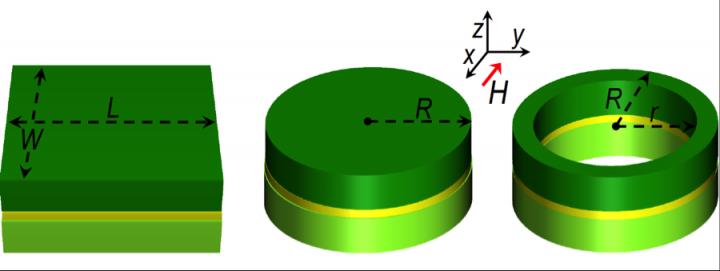A small, inexpensive high frequency comb signal generator

Josephson junctions consist of a thin layer of insulator sandwiched between two superconducting layers. Researchers from Italy found that Josephson junctions placed in an oscillating magnetic field produced voltage pulses and that changing the shape of the Josephson junction changed the amount of power at different output frequencies. A ring-shaped junction produced more power at higher harmonics than did a circular or rectangular junction. Credit: P. Solinas, et al. / JAP
The manipulation of electromagnetic radiation is an essential function of today's technology. Low frequency radiation — in the kilohertz and megahertz range — is easier to generate than gigahertz radiation. Yet higher frequencies can carry more information and travel farther.
Now researchers from the Italian National Research Council (SPIN-CNR) and the National Enterprise for nanoScience and nanoTechnology (NEST-CNR) in Italy have devised a novel, inexpensive way to turn low frequency signals into higher frequencies.
The approach makes use of a Nobel Prize-winning device called a Josephson junction, which is currently used to make extremely sensitive voltmeters and detect minute changes in magnetic fields. The researchers describe their new application in the Journal of Applied Physics, from AIP Publishing.
Josephson junctions consist of a thin layer of insulator sandwiched between two superconducting layers. Under the right conditions, electrons can travel from one superconducting layer to the other with no resistance through the insulator in the middle. When the current reaches a critical level, however, a finite resistance suddenly appears and a voltage develops across the device.
Paolo Solinas, a physicist at the Italian National Research Council, was experimenting on Josephson junctions with his colleagues at NEST-CNR when they noticed an unusual behavior. They found that Josephson junctions placed in an oscillating magnetic field produced voltage pulses. The researchers turned to theory to analyze and explain the behavior.
They found that an oscillating magnetic field produced a sudden jump in a quantum mechanical property of the superconductor layers called a phase. The phase jump in turn produced the voltage pulse. The researchers also found that a regularly time-dependent magnetic field would produce voltage pulses that contained hundreds of harmonics of the original driving frequency, including frequencies thousands of times higher.
“The output of a single device is small, but you could build an array of devices to turn low power intrinsic of a single junction into higher output power,” Solinas said. The team calculated that stringing together 1,000 Josephson junctions made from niobium and aluminum oxide could convert a 100 MHz input frequency into a 100 picowatt signal at 50 GHz.
The researchers also found that changing the shape of the Josephson junction changed the amount of power at different output frequencies. They found that a ring-shaped junction produced more power at higher harmonics than did a circular or rectangular junction.
A frequency converter made from Josephson junctions would be a totally different type of signal generator from what's currently used, Solinas noted. Most gigahertz signal generators are bulky and expensive. Electronic circuits made from Josephson junctions could be mere millimeters long and integrate easily into electronic chips.
“So far we have theoretical results, but we are really looking forward to having a match with experiment,” Solinas said. The team hopes their initial finding will interest others in building the devices. At first the technology would likely be used in the lab to calibrate measurements and perform experiments, Solinas said. With further development, it might also be used by the telecommunications industry.
###
The article, “Radiation comb generation with extended Josephson junctions,” is authored by P. Solinas, R. Bosisio and F. Giazotto. It will be published in the Journal of Applied Physics on September 15, 2015 (DOI: 10.1063/1.4928679). After that date, it can be accessed at: http://scitation.
The authors of this paper are affiliated with the Italian National Research Council (SPIN-CNR) and the National Enterprise for nanoScience and nanoTechnology (NEST-CNR) in Italy.
ABOUT THE JOURNAL
Journal of Applied Physics is an influential international journal publishing significant new experimental and theoretical results of applied physics research. See: http://jap.
Media Contact
All latest news from the category: Physics and Astronomy
This area deals with the fundamental laws and building blocks of nature and how they interact, the properties and the behavior of matter, and research into space and time and their structures.
innovations-report provides in-depth reports and articles on subjects such as astrophysics, laser technologies, nuclear, quantum, particle and solid-state physics, nanotechnologies, planetary research and findings (Mars, Venus) and developments related to the Hubble Telescope.
Newest articles

Superradiant atoms could push the boundaries of how precisely time can be measured
Superradiant atoms can help us measure time more precisely than ever. In a new study, researchers from the University of Copenhagen present a new method for measuring the time interval,…

Ion thermoelectric conversion devices for near room temperature
The electrode sheet of the thermoelectric device consists of ionic hydrogel, which is sandwiched between the electrodes to form, and the Prussian blue on the electrode undergoes a redox reaction…

Zap Energy achieves 37-million-degree temperatures in a compact device
New publication reports record electron temperatures for a small-scale, sheared-flow-stabilized Z-pinch fusion device. In the nine decades since humans first produced fusion reactions, only a few fusion technologies have demonstrated…





















